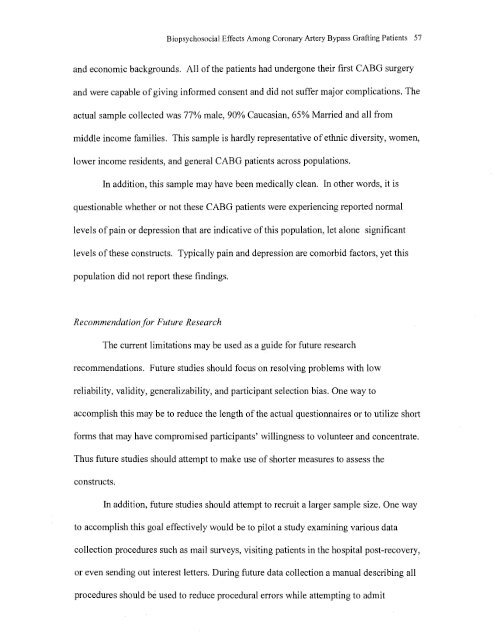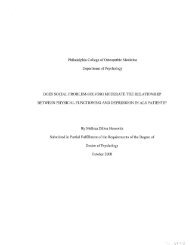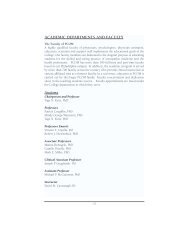0 - Philadelphia College of Osteopathic Medicine
0 - Philadelphia College of Osteopathic Medicine
0 - Philadelphia College of Osteopathic Medicine
You also want an ePaper? Increase the reach of your titles
YUMPU automatically turns print PDFs into web optimized ePapers that Google loves.
Biopsychosocial Effects Among Coronary Artery Bypass Grafting Patients 57<br />
and economic backgrounds. All <strong>of</strong> the patients had undergone their first CABG surgery<br />
and were capable <strong>of</strong> giving informed consent and did not suffer major complications. The<br />
actual sample collected was 77% male, 90% Caucasian, 65% Married and all from<br />
middle income families. This sample is hardly representative <strong>of</strong> ethnic diversity, women,<br />
lower income residents, and general CABG patients across populations.<br />
In addition, this sample may have been medically clean. In other words, it is<br />
questionable whether or not these CABG patients were experiencing reported normal<br />
levels <strong>of</strong> pain or depression that are indicative <strong>of</strong> this population, let alone significant<br />
levels <strong>of</strong> these constructs. Typically pain and depression are comorbid factors, yet this<br />
population did not report these findings.<br />
Recommendation for Future Research<br />
The current limitations may be used as a guide for future research<br />
recommendations. Future studies should focus on resolving problems with low<br />
reliability, validity, generalizability, and participant selection bias. One way to<br />
accomplish this may be to reduce the length <strong>of</strong> the actual questionnaires or to utilize short<br />
forms that may have compromised participants' willingness to volunteer and concentrate.<br />
Thus future studies should attempt to make use <strong>of</strong> shorter measures to assess the<br />
constructs.<br />
In addition, future studies should attempt to recruit a larger sample size. One way<br />
to accomplish this goal effectively would be to pilot a study examining various data<br />
collection procedures such as mail surveys, visiting patients in the hospital post-recovery,<br />
or even sending out interest letters. During future data collection a manual describing all<br />
procedures should be used to reduce procedural errors while attempting to admit






